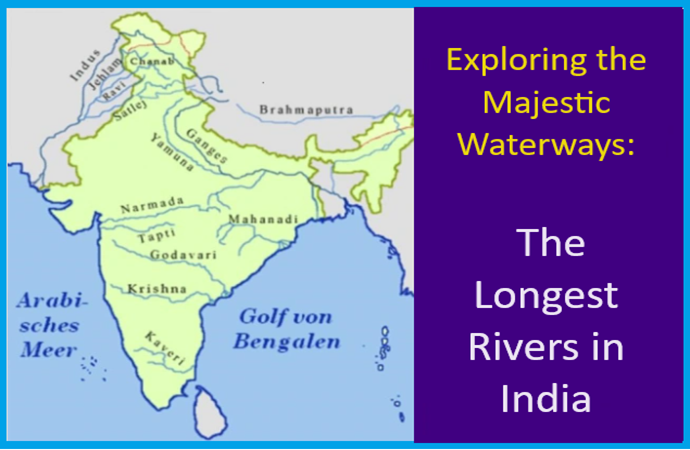Contents
- 1 Introduction: Exploring the Majestic Waterways: The Longest Rivers in India
- 1.1 The Ganges (2,525 kilometers):
- 1.2 The Godavari (1,465 kilometers):
- 1.3 The Yamuna (1,376 kilometers):
- 1.4 The Brahmaputra (2,900 kilometers):
- 1.5 The Indus (3,180 kilometers):
- 1.6 The Krishna (1,400 kilometers):
- 1.7 The Narmada (1,312 kilometers):
- 1.8 The Tapti (724 kilometers):
- 1.9 The Mahanadi (858 kilometers):
- 1.10 The Son (784 kilometers):
- 1.11 The Luni (495 kilometers):
- 1.12 The Beas (470 kilometers):
- 1.13 The Sutlej (1,450 kilometers):
- 1.14 The Ravi (720 kilometers):
- 1.15 The Betwa (590 kilometers):
- 1.16 The Pennar (597 kilometers):
- 1.17 The Kaveri (805 kilometers):
- 1.18 The Subarnarekha (395 kilometers):
- 1.19 The Tungabhadra (531 kilometers):
- 1.20 The Sabarmati (371 kilometers):
- 1.21 The Ghaghara (1,080 kilometers):
- 1.22 The Gandak (630 kilometers):
- 1.23 The Damodar (541 kilometers):
- 1.24 The Musi (240 kilometers):
- 1.25 The Yamuna (1,376 kilometers):
- 1.26 The Lohit (1,130 kilometers):
- 1.27 The Kosi (720 kilometers):
- 1.28 The Manjira (724 kilometers):
- 1.29 The Bhavani (217 kilometers):
- 1.30 The Palar (348 kilometers):
- 1.31 The Mahanadi (858 kilometers):
- 1.32 The Brahmani River: 800 kilometers
- 1.33 The Subarnarekha River: 395 kilometers
- 1.34 The Rushikulya River: 165 kilometers
- 1.35 The Vamsadhara River: 254 kilometers
- 1.36 Frequently Asked Questions (FAQ) on the Longest Rivers in India:
- 1.36.1 Which is the longest river in India?
- 1.36.2 What is the significance of the Ganges River?
- 1.36.3 How does the Ganges River impact the regions it flows through?
- 1.36.4 Which rivers are the major tributaries of the Ganges?
- 1.36.5 What is the length of the Brahmaputra River?
- 1.36.6 How does the Brahmaputra impact India and neighboring countries?
- 1.36.7 Which are the other major rivers in India?
- 1.36.8 Are there any significant dams built on these rivers?
- 1.36.9 How do rivers contribute to India’s cultural heritage?
- 1.36.10 What challenges do these rivers face in contemporary times?
Introduction: Exploring the Majestic Waterways: The Longest Rivers in India
India is a land blessed with diverse landscapes, and its rivers play a crucial role in shaping the country’s geography and culture. From the mighty Himalayas to the vast plains and coastal regions, India’s rivers traverse various terrains, offering breathtaking views and sustaining millions of lives. In this blog post, we’ll delve into the list of the longest rivers in India, each with its unique significance.
-
The Ganges (2,525 kilometers):
- Originating from the Gangotri Glacier in the state of Uttarakhand, the Ganges is the longest river in India. Flowing through the northern plains, it passes through states like Uttar Pradesh, Bihar, and West Bengal before finally emptying into the Bay of Bengal. The Ganges holds immense religious importance for Hindus and is central to various rituals and traditions.
-
The Godavari (1,465 kilometers):
- Known as the “Dakshin Ganga,” the Godavari is the second-longest river in India. Originating in the central Indian state of Maharashtra, it flows through several states, including Telangana, Andhra Pradesh, and Chhattisgarh, before meeting the Bay of Bengal. The Godavari is not only significant for its length but also for supporting agricultural activities along its banks.
-
The Yamuna (1,376 kilometers):
- A major tributary of the Ganges, the Yamuna originates from the Yamunotri Glacier in Uttarakhand. Flowing through states such as Haryana, Delhi, and Uttar Pradesh, the Yamuna merges with the Ganges at Allahabad. The river holds historical importance, and its banks are dotted with numerous temples and historical sites.
-
The Brahmaputra (2,900 kilometers):
- Although the Brahmaputra’s primary course lies in Tibet, it enters India in the state of Arunachal Pradesh. Flowing through Assam and merging with the Ganges in Bangladesh, the Brahmaputra is one of the major rivers in the world. It is known for its turbulent currents, diverse flora and fauna, and its role in shaping the fertile plains of Assam.
-
The Indus (3,180 kilometers):
- While the majority of the Indus River lies in present-day Pakistan, it also flows through the Indian territory of Jammu and Kashmir. Originating in Tibet, the Indus is one of the longest rivers globally and has played a significant historical role in the development of the ancient Indus Valley Civilization.
-
The Krishna (1,400 kilometers):
- Originating from the Western Ghats in the state of Maharashtra, the Krishna River flows through Karnataka, Telangana, and Andhra Pradesh before reaching the Bay of Bengal. Known for its importance in ancient Indian epics and mythology, the Krishna River is a vital source for irrigation and hydropower generation, contributing to the agricultural prosperity of the region.
-
The Narmada (1,312 kilometers):
- Often referred to as the “Life Line of Madhya Pradesh,” the Narmada River originates from the Amarkantak Plateau and flows through the states of Madhya Pradesh and Gujarat. The Narmada has a unique feature – it flows westward, cutting through the Vindhya and Satpura mountain ranges. The river is revered for its scenic beauty and is home to the famous Marble Rocks near Jabalpur.
-
The Tapti (724 kilometers):
- Originating from the Betul district in Madhya Pradesh, the Tapti River flows through Maharashtra and Gujarat, eventually emptying into the Gulf of Khambhat. The river is essential for the agricultural activities in the region and holds historical significance, with ancient temples and sites along its banks.
-
The Mahanadi (858 kilometers):
- Originating from the Chhattisgarh region, the Mahanadi River flows through Odisha, supporting extensive agriculture and providing water for industries. The Hirakud Dam, one of the longest dams in the world, is built across the Mahanadi and serves multiple purposes, including irrigation, flood control, and electricity generation.
-
The Son (784 kilometers):
- A major tributary of the Ganges, the Son River originates in the Amarkantak Plateau and flows through the states of Madhya Pradesh, Chhattisgarh, Jharkhand, and Bihar. Known for its rugged landscapes and rocky terrain, the Son River is crucial for agriculture and plays a role in the industrial development of the region.
-
The Luni (495 kilometers):
- Flowing entirely within the northwestern state of Rajasthan, the Luni River is known for its ephemeral nature. Originating in the Aravalli Range, it traverses through the Thar Desert, making it one of the few rivers in the world that often dries up before reaching the Arabian Sea. Despite its limited length, the Luni plays a vital role in sustaining local agriculture through its ephemeral flows.
-
The Beas (470 kilometers):
- Originating in the Himalayas, the Beas River flows through the states of Himachal Pradesh and Punjab before merging with the Sutlej River. The Beas is crucial for hydroelectric power generation and supports the fertile plains of Punjab. Its clear waters and scenic surroundings also make it a popular destination for nature enthusiasts and tourists.
-
The Sutlej (1,450 kilometers):
- Emerging from Tibet, the Sutlej River flows through Himachal Pradesh and Punjab, eventually entering Pakistan. The river has played a significant historical role in shaping the region and is harnessed for hydroelectric power generation, particularly in the construction of the Bhakra-Nangal Dam, one of the largest dams in India.
-
The Ravi (720 kilometers):
- Another significant river in the northern region, the Ravi River originates in the Himalayas and flows through the Indian states of Himachal Pradesh and Jammu and Kashmir before entering Pakistan. The Ravi is known for its role in the Indus Water Treaty and its importance in sustaining agriculture in the region.
-
The Betwa (590 kilometers):
- Rising from the Vindhya Range in Madhya Pradesh, the Betwa River flows through the states of Madhya Pradesh and Uttar Pradesh. The river is dammed at various points for irrigation and water supply purposes. The Betwa is also associated with historical sites and forts, adding a cultural and heritage dimension to its significance.
-
The Pennar (597 kilometers):
- Originating in the Nandi Hills of Karnataka, the Pennar River flows through the Deccan Plateau, traversing the states of Andhra Pradesh and Tamil Nadu. Known for its diverse flora and fauna along its banks, the Pennar plays a crucial role in supporting agriculture in the arid regions it passes through.
-
The Kaveri (805 kilometers):
- Revered as the Ganges of the South, the Kaveri River is one of the major rivers in the southern part of India. Originating in the Western Ghats, it flows through Karnataka and Tamil Nadu, finally emptying into the Bay of Bengal. The Kaveri is not only vital for agriculture but also holds cultural significance, with numerous temples and historical sites along its course.
-
The Subarnarekha (395 kilometers):
- Flowing through the states of Jharkhand, West Bengal, and Odisha, the Subarnarekha River originates in the Chota Nagpur Plateau. The name “Subarnarekha” translates to “Streak of Gold,” reflecting the golden hue of its waters. The river supports agriculture and is a source of water for various industries in the region.
-
The Tungabhadra (531 kilometers):
- Originating in the Western Ghats of Karnataka, the Tungabhadra River is a tributary of the Krishna River. It flows through the Deccan Plateau, forming the Tungabhadra Reservoir, which is crucial for irrigation and hydropower generation. The river is associated with several ancient temples and historical sites, adding to its cultural significance.
-
The Sabarmati (371 kilometers):
- Flowing through the western state of Gujarat, the Sabarmati River originates in the Aravalli Range. The Sabarmati is not only a significant source of water for agriculture and industries but also gained prominence due to the Sabarmati Ashram, where Mahatma Gandhi carried out a significant part of the Indian independence movement.
-
The Ghaghara (1,080 kilometers):
- Flowing through the northern part of India, the Ghaghara River is a major tributary of the Ganges. Originating in the Tibetan Plateau, it traverses through the states of Uttarakhand, Uttar Pradesh, and Bihar. The Ghaghara is known for its turbulent waters and is an important source of water for agriculture in the Gangetic plains.
-
The Gandak (630 kilometers):
- Originating in Nepal, the Gandak River flows through the Indian states of Uttarakhand, Bihar, and Uttar Pradesh, before joining the Ganges. The river is significant for its role in irrigation, and the Gandak Project has been instrumental in harnessing its waters for agricultural development in the region.
-
The Damodar (541 kilometers):
- Known as the “Sorrow of Bengal” due to its historical floods, the Damodar River originates in Jharkhand and flows through West Bengal. The Damodar Valley Corporation was established to control floods and generate hydroelectric power, showcasing the river’s dual importance in the region.
-
The Musi (240 kilometers):
- Flowing through the city of Hyderabad in Telangana, the Musi River is a tributary of the Krishna River. Historically, the Musi has played a crucial role in the development of the region, and its waters are utilized for irrigation and urban water supply.
-
The Yamuna (1,376 kilometers):
- While the Yamuna has already been mentioned as a tributary of the Ganges, it’s worth noting that the Yamuna itself is a significant river in its own right. Originating from the Yamunotri Glacier, it flows through the northern plains, passing through Delhi and Agra, before joining the Ganges. The Yamuna is integral to the cultural and historical heritage of northern India.
-
The Lohit (1,130 kilometers):
- Originating in Tibet, the Lohit River is a major tributary of the Brahmaputra. It flows through the northeastern Indian state of Arunachal Pradesh, known for its breathtaking landscapes and diverse flora and fauna. The Lohit contributes to the fertile plains of the Brahmaputra Valley, supporting agriculture and biodiversity.
-
The Kosi (720 kilometers):
- Often referred to as the “Sorrow of Bihar,” the Kosi River originates in Tibet and flows through Nepal and the Indian state of Bihar before joining the Ganges. Known for its unpredictable and sometimes destructive floods, the Kosi is nevertheless a crucial river for agriculture in the region.
-
The Manjira (724 kilometers):
- Originating in the Balaghat Range of Maharashtra, the Manjira River flows through the states of Maharashtra, Karnataka, and Telangana. It is a major tributary of the Godavari and plays a vital role in the irrigation of agricultural lands in the region.
-
The Bhavani (217 kilometers):
- Rising in the Nilgiri Hills of Tamil Nadu, the Bhavani River is a tributary of the Kaveri. The river is known for its scenic beauty and is an important water source for both irrigation and drinking purposes in the arid regions of Tamil Nadu.
-
The Palar (348 kilometers):
- Flowing through the southern states of Karnataka and Tamil Nadu, the Palar River originates in the Nandi Hills. Despite facing water scarcity challenges, the Palar is essential for agriculture and supports the livelihoods of communities along its banks.
-
The Mahanadi (858 kilometers):
- Originating from the Chhattisgarh region, the Mahanadi River flows through Odisha, supporting extensive agriculture and providing water for industries. The Hirakud Dam, one of the longest dams in the world, is built across the Mahanadi and serves multiple purposes, including irrigation, flood control, and electricity generation.
-
The Brahmani River: 800 kilometers
- Originating in the Amarkantak hills, the Brahmani River flows through the states of Chhattisgarh and Odisha. It plays a crucial role in irrigation and is also known for the Rourkela Steel Plant, which is situated on its banks.
-
The Subarnarekha River: 395 kilometers
- As mentioned earlier, the Subarnarekha River flows through Jharkhand, West Bengal, and Odisha. It is an important river in the region, supporting agriculture and industries.
-
The Rushikulya River: 165 kilometers
- Rising in the eastern Ghats, the Rushikulya River flows through the Ganjam district of Odisha. It is known for its scenic beauty and is vital for agriculture in the region.
-
The Vamsadhara River: 254 kilometers
- Originating in the Eastern Ghats, the Vamsadhara River flows through Odisha and Andhra Pradesh. It is a significant river for the irrigation of agricultural lands in both states.
Frequently Asked Questions (FAQ) on the Longest Rivers in India:
-
Which is the longest river in India?
- The Ganges River is the longest river in India, flowing from the Gangotri Glacier in Uttarakhand to the Bay of Bengal, covering a distance of approximately 2,525 kilometers.
-
What is the significance of the Ganges River?
- The Ganges holds immense religious and cultural importance for Hindus. It is considered a sacred river, and its waters are believed to have purifying properties. The river is central to various rituals and traditions.
-
How does the Ganges River impact the regions it flows through?
- The Ganges River supports agriculture, sustains ecosystems, and provides water for numerous cities and towns along its course. It is a lifeline for millions of people, contributing to their daily lives and economic activities.
-
Which rivers are the major tributaries of the Ganges?
- The major tributaries of the Ganges include the Yamuna, Son, Gandak, Kosi, and Ghaghara rivers. These tributaries significantly contribute to the Ganges’ flow and form a complex network of waterways.
-
What is the length of the Brahmaputra River?
- The Brahmaputra River, while flowing through Tibet, India, and Bangladesh, is approximately 2,900 kilometers long. It is one of the major rivers in Asia and plays a vital role in the ecosystems of the region.
-
How does the Brahmaputra impact India and neighboring countries?
- The Brahmaputra is crucial for agriculture, transportation, and hydroelectric power generation in the regions it traverses. It contributes to the fertile plains of Assam and Bangladesh and is a lifeline for the people living along its banks.
-
Which are the other major rivers in India?
- Besides the Ganges and Brahmaputra, other major rivers in India include the Yamuna, Godavari, Krishna, Narmada, Tapi, Mahanadi, and many more. These rivers play essential roles in the country’s geography, culture, and economy.
-
Are there any significant dams built on these rivers?
- Yes, there are several significant dams built on these rivers for various purposes, such as irrigation, flood control, and hydroelectric power generation. Examples include the Bhakra-Nangal Dam on the Sutlej, the Hirakud Dam on the Mahanadi, and the Tehri Dam on the Bhagirathi River (a major tributary of the Ganges).
-
How do rivers contribute to India’s cultural heritage?
- Rivers in India are often associated with mythology, ancient civilizations, and cultural practices. They have inspired art, literature, and religious beliefs. Pilgrimages along these rivers are common, and many festivals and rituals are connected to them.
-
What challenges do these rivers face in contemporary times?
- Rivers in India face challenges such as pollution, over-extraction of water, habitat degradation, and the impact of climate change. Sustainable water management practices are crucial to address these challenges and ensure the long-term health of these vital waterways.


















